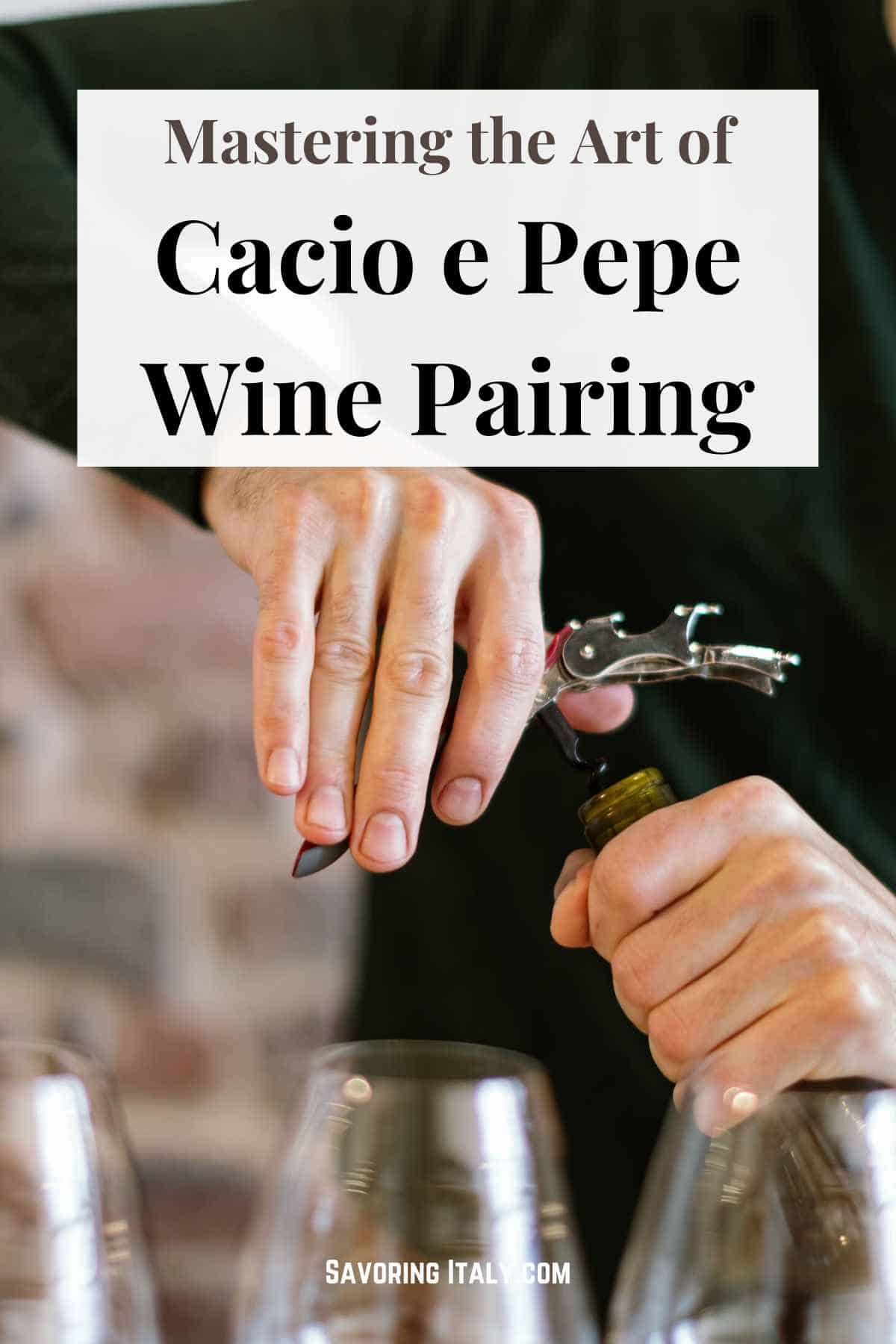Cacio e Pepe is more than pasta. It's a Roman story that needs telling and wine pairing with this dish? That's another art. Let's explore how the right wine turns a simple meal into an Italian masterpiece.

This article contains affiliate links which supports us at no extra cost to you.
Jump To

Cacio e Pepe Wine Pairing 101
Cacio e Pepe: it's pasta, it's Roman, and it's an Italian icon. It started with Roman shepherds. They called it "cheese and pepper". It was smart and super basic. It dates way back to the Roman Empire. Shepherds made it during long their long journeys across the beautiful Italian landscapes that we drool over visiting. They had spaghetti, pecorino, and black pepper. That's it. And these ingredients totally made something great. Now, it's absolutely big in Roman taverns and everywhere.
Of course, pairing wine with Italian food is also big. It's all about matching food and wine for the perfect dining experience. The right wine makes a dish better. It's a simple as that. It's especially true for Cacio e Pepe. Its creamy, peppery taste needs the right wine. White, red, or sparkling - it matters. The perfect wine makes everything better. It's a real Italian thing.
Basics of Wine Pairing
Don't stress out when wine pairing. It's definitely not rocket science. Honestly, it's simply matching the flavors of your wine and dish. Here's how I see it:
First, know your wine tastes. Reds are bitter. Whites, rosés, and sparklings are acidic. Sweet wines are totally sweet, obviously. Pair them with your food's main flavors.
There are two pairing styles. Complementary pairings contrast flavors. Think high-acid wine with fatty food. Congruent pairings double down on similar flavors. So, that's like having a "creamy" wine with a creamy dish.
Match the intensity. Don't let the wine or food overpower each other. Balance acidity, sweetness, and texture. Rich meats need bold wines. Light fish. Totally go for light whites.
Consider the food too. What's the protein? How's it cooked? What spices or sauces are used? This all changes the flavor, and your wine choice.
There's somewhat of a science here too. Aromatic molecules in food and wine create sensory bridges. They can absolutely make pairings work on a molecular level.
But hey, the bottom line is to trust your gut. What works for me might not work for you. Experiment and trust your own taste. That's the real secret to wine pairing.

Cacio e Pepe Wine Pairing: White Wine
I recommend Vermentino from Sardinia for its crisp acidity. It's got this citrus, green apple, and almond flavors. Absolutely perfect with the creamy, nutty Cacio e Pepe.
Also, try Malvasia Bianca di Candia from Lazio. I think it's fruity, floral, with a mineral kick. Balances Cacio e Pepe's savory taste.
Greco di Tufo from Campania is totally another solid choice. It's full-bodied, with honey, apricot, and mineral notes. Stands up to Cacio e Pepe's pepper.

Cacio e Pepe Wine Pairing: Red Wine
We already learned that white wine pairs well with Cacio e Pepe, but red wine works too. So, for you red wine lovers out there, you should go for the lighter reds. Chianti and Barbera, in my opinion, are good choices. They definitely handle the cheese's saltiness. And these Italian reds totally match the dish without overpowering it.
California Pinot Noir is another solid option. I think it's got a good mix: that is, a light to medium body, decent tannins, and plenty of acidity. It absolutely fits with Cacio e Pepe. French Gamay, particularly from Beaujolais, is great too. Its high acidity and low tannins suit the dish's spiciness and richness.
Chianti Classico is another winner. Its acidity and tannins are a nice balance. The red fruit scents and earthy notes in Chianti Classico enhance the Pecorino Romano cheese and black pepper in Cacio e Pepe.

Cacio e Pepe Wine Pairing: Sparkling and Rosé Options:
I say, go for a gutsy Rosé with Cacio e Pepe. It's got to punch back at that black pepper. Get one that's acidic, dry, and screams cherries, raspberries, strawberries. It wipes your mouth clean after all that cheesy richness, and dances with the spice and salt.
Domaine Tempier Rosé, that's your ticket. It comes from Provence's Bandol area. It's big, it's bold, perfect with food. The Mourvèdre grape in it? That's what gives it backbone.
Now, sparkling wines. So, in this category, definitely think Rosé sparklers for a real treat. They totally fizz and cut right through Cacio e Pepe's creamy cheese. Plus, their fruitiness absolutely balances the pepper's heat.
Serving Suggestions
Serving wine right makes or breaks its taste, especially with Cacio e Pepe. White wines go well with it, but temperatures matter. Light whites like Sardinian Vermentino need to be ice cold, between 38–45°F. That's 3-7°C. Cold makes them crisp and sharp, perfect with Cacio e Pepe's creamy kick. Heavier whites, like Malvasia Bianca from Lazio, should be just fridge cold, 44–55°F or 7-12°C. Warmer brings out fruity, floral notes, balancing the dish's savory punch.
Now, reds like Chianti work best cool, at 55–60°F. That's 12-15°C. Cooler temps keep their acidity and fruitiness alive, matching the cheese's saltiness in Cacio e Pepe. For sparkling and rosé, think 43°F to 47°F, or 6-8°C. This keeps them crisp against the dish's richness.
Glassware's key too. Different shapes boost different wines. Whites need smaller bowls to keep their scent and chill. Reds need more air, so larger bowls help.
Pairing wine and Cacio e Pepe? Mind the setting. Serve in the right glass at the right temp. It's about the vibe, making the wine-dish combo shine. But hey, it's also about what you like. Play around within these temp ranges to find your sweet spot.
Alternative Pairings
Try sparkling water, flavored water, iced tea, or fruit juices. These drinks refresh against the dish's rich, savory taste. Citrus juices like lemon add zest, matching the creamy texture. Carrot or beet juices bring unique tastes and nutrients. Sweet grape juice goes well with creamy dishes.
For non-alcoholic wines, match the sauce, not the pasta. With Cacio e Pepe's cheese sauce, go for a Chardonnay or Pinot Grigio. They highlight the cheese's creaminess. Prefer red wine? Light Pinot Noir works. It balances the dish's richness without dominating.
Other good pairings for Italian dishes? Creamy pasta fits Ariel Chardonnay or Princess Alternativa 0.0. Meaty pasta goes with Mood Fossile Fiorentino or Domaine De La Prade. For pesto pasta, lemonade and lime sparkling water are perfect. They cut through pesto's richness. With meat pasta, try cranberry juice cocktail, spiced apple cider, or tomato juice.



Leave a Reply